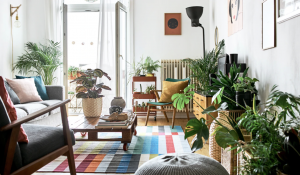
Sustainable interior design is becoming more and more popular as people become aware of the impact that their homes have on the environment. By making simple changes to the way we decorate and design our homes, we can reduce our carbon footprint and create a healthier living space for ourselves and our families. To make your home eco-friendly, consider using sustainable materials such as bamboo, reclaimed wood, and recycled glass. Choose energy-efficient appliances and light fixtures, and incorporate natural elements such as plants to improve indoor air quality.
As concern for the environment grows, sustainable interior design has become increasingly popular. Sustainable interior design is all about creating a healthy and eco-friendly home environment that reduces waste and promotes energy efficiency. In this guide, we will explore the various ways to incorporate sustainable practices into your interior design.
- Choose Sustainable Materials
One of the easiest ways to make your home more sustainable is to use materials that have a lower environmental impact. When selecting materials, opt for natural and renewable resources, such as bamboo or cork. These materials are not only sustainable but also add a unique touch to your home decor.
2. Energy Efficiency
Energy-efficient homes can reduce your carbon footprint and save money on your energy bills. Consider investing in energy-efficient appliances and light fixtures. You can also improve the insulation in your home to reduce heat loss and lower your energy usage.
3. Reduce Water Waste
Water conservation is essential to sustainable living. You can reduce water waste in your home by investing in low-flow toilets and showerheads. You can also install rainwater harvesting systems to collect rainwater for outdoor use.
4. Upcycling and Recycling
Upcycling and recycling are great ways to reduce waste and give old items a new life. You can repurpose old furniture or decor items, such as turning an old ladder into a bookshelf. Recycling is also crucial in reducing waste. Make sure to separate your recyclables and dispose of them properly.
5. Use Non-Toxic Products
Using non-toxic products is essential to creating a healthy home environment. Many household cleaners and chemicals contain harmful toxins that can impact indoor air quality. Opt for eco-friendly and non-toxic products when cleaning or choosing furniture and decor items.
6. Natural Lighting
Natural lighting is an essential aspect of sustainable interior design. Natural light not only reduces your energy consumption but also promotes a healthy and positive home environment. Make sure to keep your windows clean and unobstructed to allow natural light into your home.
7. Sustainable Furniture
When choosing furniture for your home, consider investing in sustainable options. Look for furniture made from natural and renewable materials, such as reclaimed wood. You can also choose furniture made from recycled materials, such as plastic bottles.
8. Indoor Plants
Indoor plants are not only aesthetically pleasing but also provide numerous health benefits. Plants purify the air and reduce toxins in your home. They can also reduce stress and promote a positive home environment.
In conclusion, sustainable interior design is an excellent way to create a healthy and eco-friendly home environment. By incorporating sustainable practices into your interior design, you can reduce your carbon footprint, save money, and promote a positive home environment. Remember to choose sustainable materials, improve energy efficiency, reduce water waste, upcycle and recycle, use non-toxic products, incorporate natural lighting, choose sustainable furniture, and include indoor plants.



